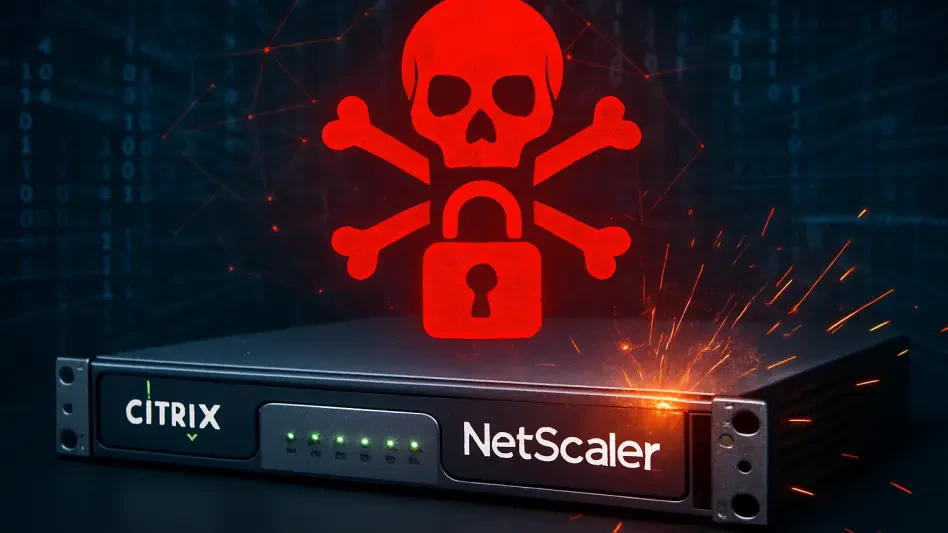What happens when a critical piece of infrastructure, trusted by thousands of enterprises worldwide, becomes a gateway for cybercriminals? Right now, Citrix NetScaler appliances—vital for secure remote access and network management—are under attack due to severe vulnerabilities, with one flaw already fueling active exploitation. This isn’t just a minor glitch; it’s a global cybersecurity crisis unfolding in real time, demanding immediate attention from organizations everywhere.
The stakes couldn’t be higher. Citrix NetScaler ADC and Gateway systems are the backbone of countless large businesses and service providers, yet thousands remain exposed to a trio of dangerous bugs, including a memory overflow flaw with a near-maximum severity score of 9.2. Dubbed CitrixBleed 3, this vulnerability is not a theoretical risk—it’s being weaponized by attackers as you read this. With historical parallels to last year’s devastating ransomware campaigns, the urgency to patch these systems has never been clearer. This story matters because every unpatched device is a potential entry point for data theft, operational disruption, and financial ruin.
Why Are So Many Systems Still Vulnerable?
Despite the availability of fixes, a staggering number of Citrix NetScaler appliances remain at risk. Data from the Shadowserver Foundation reveals that while the count of vulnerable devices dropped from over 28,000 to 13,000 in a single day, thousands are still unprotected, with over 7,500 in the US alone. This gap in security isn’t just a statistic—it represents real organizations exposed to devastating cyberattacks right now.
The issue often boils down to a phenomenon known as “patch lag.” Many enterprises, burdened by complex IT environments or limited resources, delay applying updates, leaving systems open to exploitation. This isn’t a new problem; similar delays with past Citrix flaws have led to widespread breaches, and history seems poised to repeat itself if action isn’t taken swiftly.
Compounding the challenge is a lack of awareness or prioritization. Some organizations may not even realize their systems are vulnerable, while others underestimate the speed at which attackers move. With active exploitation already underway, the window to act is shrinking by the hour, turning every unpatched device into a ticking time bomb.
The High Stakes of Unpatched Flaws
Citrix NetScaler appliances play a critical role in managing secure access and balancing network loads for major corporations and service providers. When vulnerabilities like the memory overflow bug—rated at a critical 9.2 on the CVSS scale—go unaddressed, they pave the way for remote code execution and denial-of-service attacks. Such flaws aren’t just technical issues; they threaten the very foundation of business continuity.
The real-world impact is stark. Last year’s CitrixBleed incident saw unpatched systems become conduits for ransomware, costing companies millions in damages and downtime. Today, with a new wave of flaws under attack, the potential for similar chaos looms large. Enterprises relying on these systems face not only data breaches but also reputational harm and regulatory penalties if they fail to act.
This isn’t a niche concern. From financial institutions to healthcare providers, any organization using Citrix infrastructure is at risk. The cost of inaction could be catastrophic, turning a preventable issue into a full-blown crisis that ripples across industries and borders.
Inside the Threat Landscape
The trio of vulnerabilities affecting Citrix NetScaler systems includes a particularly dangerous flaw nicknamed CitrixBleed 3, already being exploited in the wild. According to security researcher Kevin Beaumont, attackers are installing web shells on unpatched devices, a tactic that grants them persistent access for further malicious activity. This isn’t a warning of what might happen—it’s happening now.
Exposure remains alarmingly high despite some progress. While the number of vulnerable systems has decreased, thousands are still at risk, including over 4,000 in Germany and more than 1,200 in the UK. The Dutch National Cyber Security Centre (NCSC-NL) has flagged common configurations in these systems as prime targets for mass exploitation, highlighting how widespread setups amplify the danger.
The pace of response continues to lag behind the threat. Attackers move with ruthless efficiency, exploiting flaws within days of their disclosure, while many organizations struggle to keep up. This imbalance creates a dangerous window of opportunity for cybercriminals, one that could lead to a surge in breaches if not addressed immediately.
Voices of Warning from Experts
Security professionals and government agencies are united in their urgency. Kevin Beaumont, a noted cybersecurity expert, has been tracking the exploitation of CitrixBleed 3 in real time, warning that attackers are moving faster than many organizations can respond. His observations paint a grim picture of systems being compromised before IT teams even have a chance to react.
Authoritative bodies are stepping in with clear directives. The US Cybersecurity and Infrastructure Security Agency (CISA) has listed the primary flaw in its Known Exploited Vulnerabilities catalog, making patching mandatory for federal agencies. Meanwhile, NCSC-NL has issued stark predictions of a potential crisis, expressing frustration over the slow uptake of fixes across both public and private sectors.
Citrix itself has pushed for immediate action but provided little detail on the scale of current breaches. This lack of transparency leaves IT administrators grappling with uncertainty, forced to rely on external alerts and their own monitoring to gauge the threat. The consensus is clear: hesitation is no longer an option.
Steps to Lock Down Citrix Systems
Protecting Citrix NetScaler appliances demands swift and decisive measures. Start by identifying whether affected versions of ADC or Gateway systems are in use, then prioritize applying the patches Citrix has released for all three vulnerabilities. Delaying this step even by a day could mean the difference between security and compromise.
Beyond patching, vigilance is key. Deploy monitoring tools to spot signs of intrusion, such as unexpected web shells or abnormal network patterns. If patching isn’t immediately possible, isolate vulnerable systems from external access to limit exposure. Guidance from CISA offers additional best practices tailored to this threat, ensuring compliance with any applicable mandates.
Long-term resilience requires a cultural shift. Establish a robust patch management strategy with automated alerts for updates and clear accountability within IT teams. Speed must become a cornerstone of cybersecurity protocols, as the current threat landscape leaves no room for complacency. Acting now is the only way to stay ahead of attackers.
Looking back, the crisis surrounding Citrix NetScaler vulnerabilities served as a stark reminder of the fragility of digital infrastructure. Thousands of systems had been left exposed, despite available fixes, while attackers capitalized on delays with alarming efficiency. The lessons were hard-learned, as organizations scrambled to contain breaches that could have been prevented with faster response times. Moving forward, the focus shifted toward building proactive defenses—prioritizing rapid patching, enhancing monitoring, and fostering a mindset of urgency. Only through such sustained efforts could the cybersecurity community hope to outpace the evolving tactics of cybercriminals and safeguard critical systems for the years ahead.








